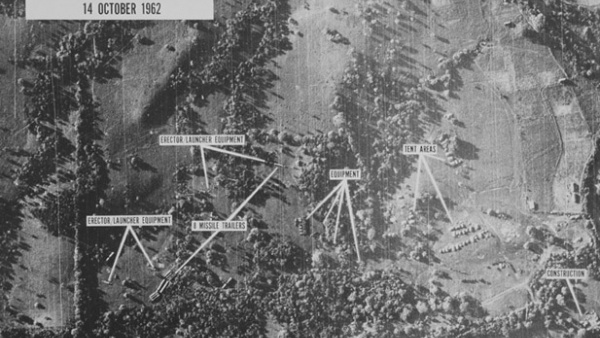October 22, 1962, US President John F Kennedy deploys a fleet of warships to Cuba,
1962年10月22日,美国总统约翰·肯尼迪向古巴派遣了一支舰队。
to intercept Soviet cargo ships, which are already on the way transporting nuclear missiles to the island.
为的是拦截一批苏联货船,因为那些货船正在向该岛运送核弹。
Kennedy strategically called the impending showdown:
肯尼迪战略性地形容即将到来的对决:
"a strict quarantine of all offensive military equipment."
“对具有十足攻击性的军事装备进行一次严格的检疫。”
What it really was, was a blockade – which is an act of aggression.
这次行动的实质却是一次封锁——也即侵略行为。
One wrong move on either side would trigger an all out nuclear war.
任何一方的一个错误举动都可能引发一场全面的核战。
And it all started here, a week earlier,
这一切还要从一个星期前,
with an aerial photograph that doesn’t seem to show much…unless you’re looking for something specific.
这里的一张航拍图说起。乍一看,这张图似乎并没有什么问题,除非你要找的是某种细节。
Pretty much immediately following the allied victory in World War II,
基本上盟军一取得二战胜利,
the United States and Soviet Union became bitter enemies…
美国和苏联就成了死对头…
kicking off a decades-long struggle for global influence known as the "Cold War".
开始了长达数十年争夺国际影响力的较量,史称“冷战”。
Espionage and intelligence were at the center of this conflict,
间谍和情报成了这场冲突的核心,
most crucially surrounding the mutual buildup of nuclear arsenals capable of unprecedented levels of destruction.
而最关键的间谍和情报活动则是围绕竞相壮大杀伤力空前的核武库展开的。
But the US initially had a hard time keeping track of their nemesis.
但一开始美国追踪敌人追踪地很艰难。
The Soviet Union was notoriously secretive, and hid itself – and its actions – from the world.
当时,苏联行事是出了名的隐秘,将自己的身份——以及行动——全部隐藏起来不让外界知道。
"An iron curtain has descended across the continent.
“一幅铁幕笼罩了整个欧洲大陆。
Nobody knows what Soviet Russia intends to do in the immediate future."
谁也不知道苏联接下来的打算。”
Then-US President Dwight D Eisenhower saw a solution
时任美国总统艾森豪威尔想到了一个办法,
that built on experimental intelligence gathering from World War II: Aerial photo analysis.
那就是借用二战的实验情报收集技术——航拍分析。
In the late 1950s, the new high-altitude U-2 spy plane took photo reconnaissance to the next level.
50年代末,新型高空U-2侦察机将侦察摄影上升到了一个新的高度。
It was equipped with a powerful camera and could fly at a staggering height of 70,000 feet…or, roughly 13 miles above Earth’s surface.
这种侦察机配备有一个强大的摄像头,飞行高度可达7万英尺,距离地面将近13英里。
"These cameras are described as capable of spotting a golf ball on a putting-green from 40,000 feet."
“据说,这些摄像机在4万英尺的高空连果岭上的高球都能拍到。”
In 1961, Eisenhower authorized the creation of a new surveillance arm of the CIA:
1961年,艾森豪威尔授权中央情报局成立了一个新的监视部门:
the National Photographic Interpretation Center, or NPIC.
国家照片解析中心,简称NPIC。
This small team of photo interpreters was trained in photogrammetry,
这个照片解读小组受过摄影测量学方面的训练,
the science of determining measurements from photographs.
而摄影测量学是一门研究从照片中确定测量值的学科。
Using this method, an expert photo interpreter could identify specific equipment hidden in the tiny details of photographs…
有了这种方法,照片解读专家就可以识别隐藏在照片细节中的某些设备,
and recognize signs of nuclear missile site construction.
继而识别出核弹研发基地的标记。
So what’s all this got to do with Cuba?
问题是,这一切跟古巴有什么关系呢?
After the failed Bay of Pigs invasion in 1961,
1961年,美国为推翻古巴的共产主义政府
where the US attempted to overthrow Cuba's communist government,
发动的猪湾入侵行动失败后,
ties between the Soviet Union and Cuba strengthened.
苏联和古巴之间的关系变得更为密切了。
The US worried that the Soviets might use Cuba as a nuclear missile base.
美国担心苏联会把古巴变成自己的核导弹基地。
If so, they would suddenly have the Western Hemisphere within range of nuclear weapons.
这样一来,西半球突然就落到了苏联核武器的打击范围之内。
The CIA began flying U-2 missions over Cuba and bringing the imagery to the NPIC,
中情局便开始在古巴上空执行U-2航拍任务,他们将拍到的图像发给照片解析中心之后,
whose photo interpreters pored over every detail, searching for evidence of Soviet presence on the island.
中心的照片解析人员就会仔细研究岛上的每一个细节,寻找苏联存在的证据。
It was like looking for a needle in a mile-long haystack –
这种方法无异于大海捞针——
that’s how much film a single U-2 mission yields, covering huge amounts of land.
而一次U-2任务就能覆盖大片土地,拍出的胶片着实不少。
But on October 15th, 1962, Dino Brugioni, a senior photo interpreter, found something.
不过,1962年10月15日,高级图片解析专家迪诺·布鲁吉奥尼还真的发现了问题。

This photo proved, beyond doubt, that the Soviets were building nuclear missile sites in Cuba.
这张照片确凿地证明了苏联的确在古巴建造核导弹基地。
Brugioni identified military tents and trucks, arranged in known-Soviet patterns.
布鲁吉奥尼辨认出了按照著名的苏联模式排列的军用帐篷和卡车。
Launcher equipment. And, most critically, missile transport trailers measuring 65 feet in length.
发射装备。最最重要的是,他辨认出了65英尺(约20米)长的导弹运输拖车。
Which, when compared to a photo taken in Moscow,
与在莫斯科拍摄的照片一对照,
made it a perfect match for the Soviet SS-4…which had a range of 1,100 nautical miles,
发现这一尺寸与苏联SS-4导弹的尺寸完全吻合,而苏联SS-4导弹的射程为1100海里,
meaning American cities as far as Washington, DC would be in reach.
这就意味着,即便是华盛顿特区这样遥远的城市,都在它的射程之内。
When the NPIC briefed Kennedy on what they’d found,
照片解读中心向肯尼迪汇报了他们的发现后,
the president ordered a scaling up of U-2 missions to photograph and analyze all of Cuba.
总统命令扩大U-2的侦查规模,将整个古巴纳入拍摄和分析的范畴。
Photo analysts updated Kennedy daily and in secret on their progress,
照片解读专家们每天都要向肯尼迪秘密汇报进展情况,
which gave him time to decide how to confront the Soviet Union.
为他决定如何对抗苏联争取时间。
Given the evidence, Kennedy was strongly advised to launch air strikes against the missile sites and invade Cuba.
鉴于上述那些证据,有人强烈建议肯尼迪发动空袭,打击那些导弹发射基地,并入侵古巴。
But he took a more measured approach with his –: "strict quarantine of all offensive military equipment."
但他采取了更为慎重的做法,表示要“对具有十足攻击性的军事装备进行一次严格的检疫。”
Which kicked off 6 intense days between the US and the Soviet Union,
由此开启了美国和苏联长达6天的紧张对峙,
with Soviet Premier Nikita Krushchev calling Kennedy’s move
苏联总理尼基塔·赫鲁晓夫称肯尼迪此举
"an act of aggression that pushes mankind to the abyss of world nuclear missile war."
“是将人类推入世界核导弹战争深渊的侵略行为。”
"Round the clock processing of their film shows that work on the missile sites is being accelerated.
24小时的胶片分析显示,导弹发射基地的工作正在加速。”
The damning photos were revealed to allies at the United Nations,
就在美国迅速调遣军队并处于高度戒备状态,
as the US military rapidly mobilized and was placed on high alert, and Cuba prepared for another invasion.
古巴也准备迎战二次入侵时,这些该死的照片被泄露给了联合国的盟友。
But when Soviet freighters reached the quarantine line….
然而,当那些苏联货船抵达隔离带时……
"A Soviet-chartered vessel Amaruchla is stopped, boarded, and inspected, then cleared to proceed to Cuba.
“一艘苏联租来的阿玛鲁契拉号船被拦截、登船、检查,结果获准可以前往古巴。
Apparently the Soviet vessels loaded with offensive weapons have turned back."
显然,满载攻击性武器的苏联货船已经折返。”
A few days later, Kennedy received a message from Kruschev.
几天后,肯尼迪收到了克鲁晓夫的一封信。
The Soviet Union had agreed to withdraw from Cuba in exchange for the US removing missiles it had placed in Turkey and Italy.
苏联同意从古巴撤军,条件是美国要撤除此前在土耳其和意大利部署的导弹。
So, the nuclear missile sites were dismantled and the Soviets left,
最后,古巴的核导弹基地被拆除,苏联人也离开了,
Transporting their nuclear missiles with them back across the Iron Curtain.
带着他们的核导弹穿过铁幕回到了苏联。
In a personal thank you letter to the NPIC,
在一封致NPIC的个人感谢信中,
Kennedy emphasized the importance of the "analysis and interpretation of the Cuban photography"
肯尼迪强调,“分析和解读拍摄古巴的照片”
in advising the US’s response in what is now called the Cuban Missile Crisis.
在为美国应对现在所谓的“古巴导弹危机”出谋划策时发挥了重要的作用。
"In summary: the Soviet Union did embark upon a bold venture
“总之,苏联当时确实踏上了一次冒险之旅,
to establish clandestinely in the Western Hemisphere a major offensive weapons base.
企图在西半球秘密建立一个大型攻击性武器基地。
That they were deterred in this effort is in large part attributable to the type of reconnaissance photography that we have just reviewed."
而我们之所以能挫败他们的这一尝试,很大程度上是我们刚刚讨论的侦察摄影的功劳。”


